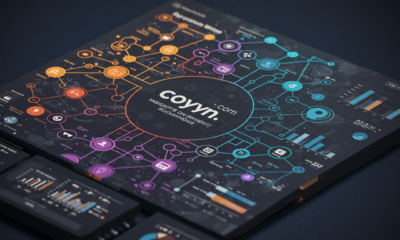Culture & Society
Arcyart Blog: 10 Ways This Platform Revolutionizes the Art World
In the modern digital landscape, where content is abundant and attention spans are limited, finding a high-quality platform dedicated to art is refreshing. Arcyart Blog emerges as one such vibrant hub, bridging gaps between contemporary artists, art enthusiasts, and educational institutions. Unlike many generic art sites, Arcyart Blog blends curation, critique, and connection in a way that resonates globally.
From curated artist showcases to deep-dive reviews and learning materials, Arcyart Blog does not merely publish content—it creates a movement. Through a seamless combination of insightful narratives and visual stimulation, it has become a trusted source for anyone passionate about the arts.
Let us now explore the features, significance, and global influence of Arcyart Blog in more detail.
1. Championing Emerging Talent Across Continents
Arcyart Blog places a distinct emphasis on emerging artists. While many mainstream art blogs stick to established names, Arcyart dares to be different. It identifies and promotes new voices from around the globe, offering them a platform to shine.
How This Works:
- Bi-weekly artist spotlights
- Portfolio features
- Exclusive interviews
Consequently, many artists featured on Arcyart have gone on to exhibit internationally, gaining recognition and career opportunities they might not have received otherwise.
2. Curated Insights and Expert Reviews
Transitioning from artist features, Arcyart Blog excels in art critique and analysis. Instead of superficial commentary, the blog delivers in-depth reviews that examine the technique, symbolism, and impact of the artwork.
Key Benefits:
- Balanced opinions
- Rich contextual information
- Cultural and historical references
These reviews are written not only for critics but also for lay readers, making art more approachable and enjoyable for all.
3. A Hub for Art Education
Another major strength of the Arcyart Blog is its commitment to art education. In a world where formal art schooling is often inaccessible or costly, Arcyart levels the playing field by offering free, quality educational resources.
Educational Offerings Include:
- Glossaries of art terms
- Step-by-step painting and drawing tutorials
- Analysis of art movements and periods
Moreover, educators frequently use Arcyart Blog content in their lesson plans, further establishing its authority in the educational domain.
4. Supporting Digital and Traditional Media Equally
Where some blogs favor digital media or remain rooted in tradition, Arcyart Blog bridges both worlds. This inclusive philosophy makes it a unique space for creators of all kinds.
Whether an artist is working with:
- Oils and charcoal
- Mixed media installations
- NFTs and digital illustrations
Arcyart Blog ensures equal representation and validation. This inclusive approach encourages experimentation and innovation in artistic practice.
5. Building a Global Artistic Dialogue
In today’s interconnected world, art transcends borders. Arcyart Blog plays a pivotal role in fostering global conversations about creativity, culture, and identity.
Strategies for Global Engagement:
- Featuring artists from over 70 countries
- Collaborating with international art fairs
- Publishing content in multiple languages
As a result, the blog does not just serve a local or national audience—it appeals to an international community
6. Fostering Sustainability in Art
Increasingly, artists are turning to eco-conscious practices, and Arcyart Blog is at the forefront of this movement. By promoting sustainability-themed art and spotlighting eco-friendly materials, it contributes to a more responsible and thoughtful art world.
Noteworthy Topics:
- Recycled materials in sculpture
- Eco-friendly ink and paint options
- Green art exhibitions and collectives
Transitioning toward sustainable practices is no longer optional, and Arcyart Blog is actively part of that evolution.
7. Elevating the Art Experience with Design and Accessibility
Arcyart Blog isn’t just content-rich; it’s designed for user experience. From fast loading times to intuitive navigation and mobile compatibility, it ensures that readers spend more time engaged and less time frustrated.
Design Features Include:
- Clean interface
- Categorized content
- Accessibility features for visually impaired readers
These elements, while often overlooked, significantly enhance the user experience, making art exploration a joy rather than a chore.
8. Nurturing a Vibrant Community of Art Lovers
A blog is only as strong as its community, and Arcyart Blog thrives in this area. Through social media interactions, comment sections, and artist forums, it builds meaningful connections.
Community Engagement Includes:
- Open submissions and contests
- Interactive webinars and Q&As
- Collaborative digital exhibitions
This sense of community transforms Arcyart from a one-way content hub into a collaborative art ecosystem.
9. Acting as a Launchpad for Artistic Careers
Beyond recognition, Arcyart Blog offers tangible career benefits. Numerous artists report increased sales, gallery invites, and social media growth after being featured.
Real-World Outcomes:
- Gallery representation
- Grants and residencies
- Media features and interviews
Such success stories reinforce the blog’s impact as a legitimate stepping stone for serious artists.
10. Remaining Future-Focused and Adaptive
Lastly, what truly sets Arcyart Blog apart is its future-oriented mindset. Rather than clinging to outdated models, it continuously evolves with trends in technology, society, and art.
Current Innovations:
- AR and VR exhibition previews
- Blockchain and art ownership discussions
- Live-streamed studio tours
By anticipating shifts and adapting quickly, Arcyart remains relevant and forward-thinking.
Conclusion: Why Arcyart Blog Matters Now More Than Ever
To sum up, is more than just a website; it is a cultural force. By blending art critique, global connection, education, and innovation, it offers unmatched value to artists and audiences alike.
So, if you’re searching for a platform that respects tradition, embraces innovation, and builds community, look no further than Arcyart Blog. It’s not just a blog—it’s the heartbeat of a global art revolution.
Culture & Society
Darkest Women: Exploring Power, Beauty, and Mystery Across Cultures

When we hear the phrase “darkest women,” it often evokes a range of interpretations. For some, it refers to skin tone, celebrating women with the deepest complexions. For others, it speaks to personality traits—those with intense, mysterious, or even misunderstood personas. Across history, culture, and modern media, the term has been both celebrated and misrepresented. In this blog post, we will explore the multifaceted meanings behind “darkest women,” from beauty standards and cultural pride to iconic female figures and misunderstood archetypes.
The Beauty of Deep Complexion: A Global Celebration
African Heritage and Deep Skin Tones
To begin with, Africa is home to some of the darkest-skinned women on the planet. Countries such as Sudan, South Sudan, Nigeria, and Ethiopia are known for women with extraordinarily deep skin tones. For instance, South Sudanese model Nyakim Gatwech, often referred to as the “Queen of the Dark,” has garnered international attention not only for her stunning beauty but also for promoting self-love and racial pride. Her radiant, ebony complexion challenges outdated beauty standards and redefines what it means to be beautiful.
Melanesian Women of Papua New Guinea
Interestingly, some of the darkest women can also be found outside of Africa. In Papua New Guinea, particularly among the Melanesian population, women often have extremely dark skin. Their unique genetic makeup, which is unrelated to African descent, reveals the incredible diversity of dark-skinned populations around the world. Despite geographical separation, their appearance resonates globally as a symbol of natural beauty and strength.
Transitioning Beauty Standards: Then and Now
Colonial Influence and Colorism
For centuries, darker-skinned women have faced prejudice, largely influenced by colonialism and Western beauty standards. As a result, colorism—the preferential treatment of lighter skin within communities of color—became rampant. Women with the darkest skin were often marginalized or deemed less attractive. Unfortunately, this has led many to seek skin-lightening treatments, which carry harmful physical and psychological consequences.
The Rise of the Melanin Movement
Fortunately, times are changing. The rise of the melanin movement has led to a cultural shift in how dark-skinned women are perceived. Social media platforms, particularly Instagram and TikTok, have become powerful tools for amplifying their voices. Hashtags like #melaninpoppin and #blackgirlmagic celebrate dark beauty, encouraging young women to embrace their complexion. This shift marks a pivotal moment in redefining global beauty ideals.
Dark Archetypes in Mythology and Pop Culture
The Mysterious Femme Fatale
Beyond physical appearance, the concept of the “darkest women” often embodies the femme fatale archetype—a mysterious, seductive, and powerful woman. Characters like Morticia Addams from The Addams Family and Catwoman in various Batman adaptations exemplify this dark allure. While often portrayed as morally ambiguous, these characters command attention and respect.
Goddesses of Darkness
In many cultures, dark goddesses symbolize power, creation, destruction, and mystery. Take Kali from Hindu mythology, a fierce deity associated with death and rebirth. Though terrifying to some, she is revered by millions as a divine mother. Similarly, the Greek goddess Nyx, the personification of night, embodies primal strength and cosmic balance. These figures highlight that darkness, far from being evil, can represent depth, wisdom, and transformation.
Real-Life Figures with Dark Personas
Queen Nzinga of Ndongo and Matamba
Historically, one of the most formidable women of African descent was Queen Nzinga, who ruled parts of modern-day Angola in the 17th century. Known for her strategic mind and fierce resistance against Portuguese colonization, Nzinga has been immortalized as a symbol of black resistance and strength. Her “darkness” lay not in evil but in her unyielding spirit and command.
Bell Hooks: Intellectual and Cultural Powerhouse
While not a historical ruler, bell hooks—a celebrated African-American author and feminist—embodied a different kind of darkness: intellectual depth. Her writings on race, gender, and capitalism exposed the harsh truths often ignored by mainstream discourse. Through her words, she empowered generations of women, particularly black women, to reclaim their voice.
The Role of Media in Shaping Perceptions
Stereotyping Dark Women in Film and TV
Despite progress, mainstream media continues to grapple with portraying dark-skinned women authentically. All too often, they are relegated to roles of maids, sidekicks, or hyper-aggressive characters. These tropes reinforce negative stereotypes and limit nuanced storytelling. Films like Precious and shows like Insecure, however, offer more layered depictions, paving the way for more inclusive narratives.
Fashion Industry’s Embrace of Dark Models
In the fashion world, representation has improved markedly. Models like Duckie Thot, Ajuma Nasenyana, and Anok Yai have walked global runways and graced magazine covers. Notably, Anok Yai made history as the second black model to open a Prada show—20 years after Naomi Campbell. These milestones are not only career achievements but also cultural milestones that broaden society’s beauty ideals.
The Dark Woman as an Agent of Change
Activism and Social Justice
Many of the darkest women—both literally and symbolically—are at the forefront of social justice movements. From Angela Davis in the civil rights era to modern activists like Tamika Mallory, these women carry the torch for equity and freedom. Their strength and resilience often stem from surviving systemic oppression, making their voices vital in shaping a more just society.
Literature and the Dark Feminine Voice
Authors like Toni Morrison, Zora Neale Hurston, and Alice Walker have created literary landscapes where dark-skinned women are central, complex characters. Through their stories, they challenge mainstream narratives, offering instead a rich tapestry of pain, beauty, love, and survival. This literary tradition forms a crucial part of understanding the emotional and psychological depth behind the term “darkest women.”
Breaking the Binary: Embracing Complexity
Darkness Is Not Evil
Too often, darkness is equated with negativity or evil. However, darkness can also symbolize safety, mystery, introspection, and growth. Much like night provides rest, darkness in personality or appearance can be a source of strength and peace. In spiritual traditions, shadow work—acknowledging the dark parts of the psyche—is a path to healing and self-awareness.
Intersectionality and Identity
It’s essential to recognize that the darkest women do not exist within a single box. Their identities are shaped by intersectionality—a term coined by Kimberlé Crenshaw that acknowledges overlapping systems of oppression based on race, gender, class, and more. Understanding this framework allows for deeper empathy and richer conversations about what it truly means to be “dark.”
Modern Movements and Empowerment
Beauty Brands and Representation
The beauty industry, once notoriously exclusive, is slowly evolving. Brands like Fenty Beauty by Rihanna have set new standards for inclusivity, offering foundation shades for even the deepest skin tones. This shift goes beyond profit—it sends a powerful message: all skin tones are beautiful and deserve equal celebration.
Empowerment Through Digital Platforms
Platforms like YouTube, Instagram, and TikTok have democratized beauty and storytelling. Women who once had no representation in mainstream media now build empires through content creation, beauty tutorials, motivational talks, and storytelling. Influencers like Jackie Aina use their platforms not just for product reviews but also for social commentary, bridging beauty with activism.
Conclusion: Redefining What It Means to Be “Darkest”
In conclusion, the term “darkest women” should no longer be confined to outdated, superficial, or negative connotations. Whether referring to the richness of skin tone, the depth of personality, or the powerful archetypes of history and mythology, darkest women hold a unique place in the global narrative. They challenge norms, redefine beauty, command mystery, and lead movements.
Indeed, their darkness is not something to fear—it is something to honor. From queens and goddesses to activists and artists, the legacy of the darkest women is one of resilience, power, and unshakable presence. As the world grows more inclusive, it is essential to ensure that these stories are told, celebrated, and passed down through generations.
-

 Business8 months ago
Business8 months agoCoyyn.com Economy | Insights on Gig & Digital Economies
-

 Reviews9 months ago
Reviews9 months agoDelta Touch Faucet Reviews – (Buying Guide 2025)
-
Reviews9 months ago
Kraus Faucet Reviews – (Buying Guide 2025)
-
Reviews9 months ago
Pfister Faucet Reviews – (Buying Guide 2025)
-

 Reviews9 months ago
Reviews9 months agoGlacier Bay Faucet Reviews
-
Reviews9 months ago
Brizo Kitchen Faucet Reviews – (Buying Guide 2025)
-
Reviews9 months ago
Grohe Faucet Reviews – (Buying Guide 2025)
-
Reviews9 months ago
American Standard Colony Soft Pull-Down Review
